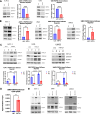Targeting FGFR4 abrogates HNF1A-driven metastasis in pancreatic ductal adenocarcinoma
- PMID: 40731412
- PMCID: PMC12306140
- DOI: 10.1186/s12943-025-02408-5
Targeting FGFR4 abrogates HNF1A-driven metastasis in pancreatic ductal adenocarcinoma
Abstract
Background: We previously identified an oncogenic role for the transcription factor HNF1A in pancreatic ductal adenocarcinoma (PDAC). However, the role of HNF1A in the metastatic progression of PDAC remains unknown and targeting modalities for HNF1A-dependent phenotypes have yet to be identified.
Methods: Transwell chambers were used to assess the effects of HNF1A and FGFR4 modulation on the migration and invasion of ATCC and patient-derived PDAC cells in vitro. An intrasplenic injection xenograft model was used to evaluate the impact of HNF1A knockdown and overexpression on metastatic tumor burden. Single-cell RNA sequencing (scRNA-seq), tissue microarray (TMA) data, and UMAP spatial profiling were used to identify FGFR4 as an HNF1A target gene upregulated in metastatic cells. RNAi and two FGFR4 inhibiting modalities (H3B-6527 and U3-1784) were utilized to demonstrate the efficacy of FGFR4 inhibiting agents at reducing HNF1A-driven metastasis.
Results: Knockdown of HNF1A significantly decreases and HNF1A overexpression significantly increases PDAC cell migration and invasion. In vivo studies show that HNF1A knockdown significantly abrogates metastasis, while overexpression significantly promotes metastasis. scRNA-seq shows that FGFR4 is upregulated in metastatic PDAC cells and staining for HNF1A and FGFR4 in a PDAC TMA reveals significant correlation between HNF1A and FGFR4 in PDAC patients. Further, knockdown and inhibition of FGFR4 significantly decreases HNF1A-mediated cell migration and invasion, and blocks HNF1A-driven metastasis in vivo.
Conclusions: These findings demonstrate that HNF1A drives PDAC metastasis via upregulation of FGFR4, and FGFR4 inhibition is a potential mechanism to target metastasis in PDAC patients.
Keywords: FGFR4; FGFR4 inhibitors; HNF1A; Metastasis; PDAC; Pancreatic ductal adenocarcinoma.
© 2025. The Author(s).
Conflict of interest statement
Declarations. Ethics approval and consent to participate: The TMA was obtained under an Institutional Review Board approved protocol at Thomas Jefferson University23,24. All animal protocols were approved by The Institute Animal Care and Use Committee (IACUC) at Roswell Park Comprehensive Cancer Center. The animal welfare assurance number for this study is A3143-01. Consent for publication: Not applicable. Competing interests: The authors declare no competing interests.
Figures







Update of
-
Targeting FGFR4 Abrogates HNF1A-driven Metastasis in Pancreatic Ductal Adenocarcinoma.bioRxiv [Preprint]. 2025 Feb 8:2025.02.06.636643. doi: 10.1101/2025.02.06.636643. bioRxiv. 2025. Update in: Mol Cancer. 2025 Jul 29;24(1):208. doi: 10.1186/s12943-025-02408-5. PMID: 39974881 Free PMC article. Updated. Preprint.
References
-
- Cancer Stat Facts: Pancreatic Cancer. (n.d.). Retrieved from National Cancer Institute Surveillance, Epidemiology, and End Results Program: https://seer.cancer.gov/statfacts/html/pancreas.html
-
- Kleeff J, et al. Pancreatic cancer Nat Rev Dis Prim. 2016;2:1–23. - PubMed
-
- Valkovicova T, Skopkova M, Stanik J, Gasperikova D. Novel insights into genetics and clinics of the HNF1A-MODY. Endocr Regul. 2019;53:110–34. - PubMed
MeSH terms
Substances
Grants and funding
LinkOut - more resources
Full Text Sources
Medical
Miscellaneous

